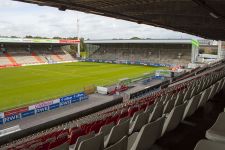Georg-Melches-Stadion was a stadium in Essen, Germany. It was built in 1923, renovated to the former state in 1939, 1948 and 1954 and had a capacity of 30,000. Due to safety reasons this was reduced to 15,000 from 1994 onwards. It was used, mostly, for football matches of Rot-Weiss Essen and concerts. The stadium was demolished by August 2012.
In 1920, the predecessor of Rot-Weiss Essen bought a piece of land at the PHonixstrasse (which was later renamed to Hafenstrasse). After the purchase it appeared that the land was too short to build a stadium. In the years after, the club purchased the remaining lands and construction of the stadium began. In 1923 the club built three stands, which could hold 10,00 spectators. In 1939 the club built a new stadium on the same location, allowing the capacity to grow to roughly 27,000. During the Second World War the stadium was heavily damaged. In 1948 the renovation and reconstruction of it was finished and in the early 1950s Rot-Weiss Essen planned on building a new multifunctional main stand.
The ideas behind this new main stand would be a revolution on the European mainland. Georg Melches had a vision a multifunctional stand, in which a sporthall, a sauna, offices, residential units, commercial units and a press room were present. The construction would be made out of concrete and in 1954 the building was officially inaugurated. German and European papers were positive on these developments and even called the stadium the German Highbury, as an example to Arsenal's former stadium. In 1952 Rot-Weiss Essen won the German Cup and in 1954 it won the German national championship. In 1956 Georg Melches and Rot-Weiss Essen installed the first floodlight installation of West Germany. The stadium was an example for other stadiums.
This page also has a version in other languages : Стадион им. Георга Мельхеса (russian)
